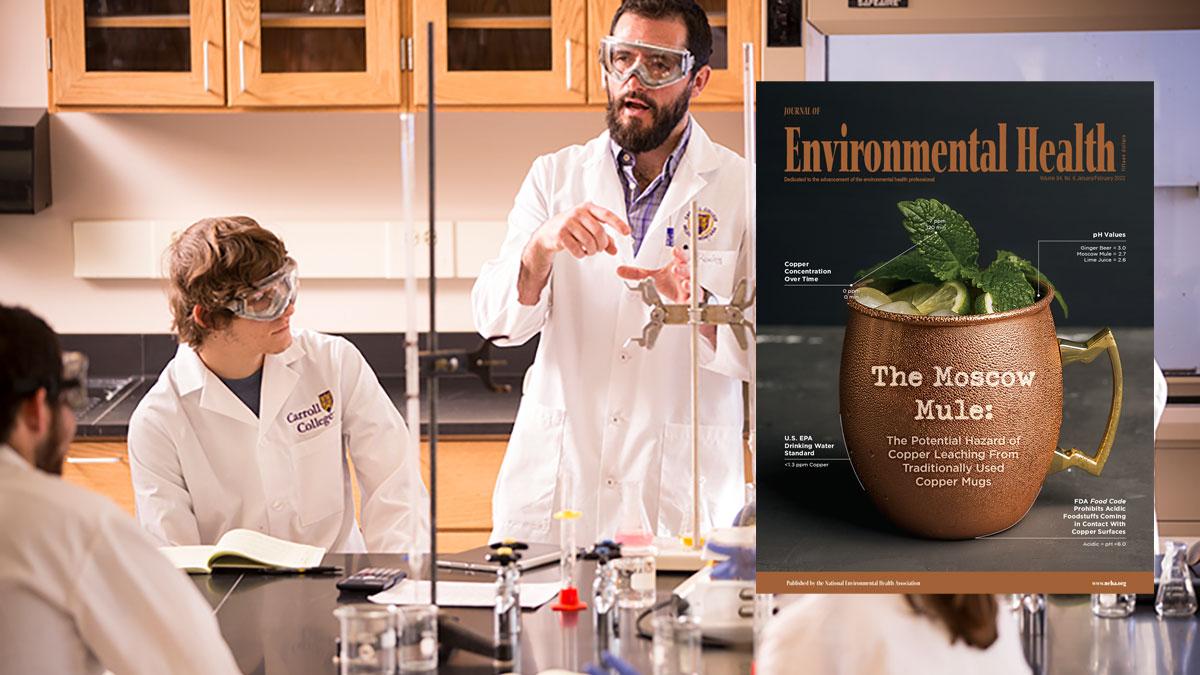HELENA – Carroll College undergraduate student researchers recently published a scientific article in the January/February issue of the Journal of Environmental Health measuring the amount of copper leaching in a Moscow Mule cocktail. By incorporating open-ended and real-world research problems into Carroll College’s chemistry courses, students are able to make meaningful contributions to the research projects, and ultimately in this case, the environmental health field.
“This research project is a great example of the fun and high-quality research that all of our chemistry students get to contribute to in our capstone Integrated Laboratory class” said Associate Chemistry Professor John Rowley. “The curriculum at Carroll College is unique because it is designed to allow all chemistry majors to master the ability to answer real-world questions that are multi-disciplinary, open-ended and loosely-defined.”
The article, titled Quantifying the rate at which copper leaches from a copper drinking vessel into simulated beverages under conditions of consumer use, provides insight into the rate, total amount, and the chemical mechanism behind copper leaching from a copper surface into foodstuffs.
The Moscow Mule cocktail, which contains ginger beer, lime juice, and vodka, is commonly served in a copper mug. There has been increasing concern that copper can leach into the cocktail, given the acidic nature of the drink. Under the experimental conditions studied, copper does leach from the copper mug into the beverage. The rate of copper leaching into the Moscow Mule cocktail was found to be significant and accumulated copper concentration exceeds the U.S. Environmental Protection Agency standards for drinking water within 27 minutes (World Health Organization, 2004). The Food and Drug Administration’s Model Food Code prohibits copper from being in direct contact with acidic foodstuffs that have a pH below 6.0. This article is a detailed study on the underlying chemistry that may motivate the FDA Model Food Code to prohibit using copper in acidic conditions. Any risk posed by the accumulation of copper, however, can be mitigated by serving the Moscow Mule cocktail in a copper mug lined with stainless steel to avoid direct contact of the acidic liquid with the copper surface directly.
This research project was spearheaded by Associate Professors of Chemistry, Dr. Caroline Pharr and Dr. John Rowley, who were the lead and principal investigators (PI). In addition, nine undergraduate students were co-authors on the published article. The success of this research project is a result of the symbiotic relationship the chemistry faculty have created between their course-based research experiences (CURES) and summer/semester research experiences (SURES). Often preliminary data and new knowledge is created by students enrolled in the course. This data and knowledge are then handed off to independent summer/semester research students. Outside the time constraints of a course, these independent semester/summer research students are able to gather the final publication quality data that is used for manuscripts like the Moscow Mule. The passing of data and knowledge from CURES to SURES (and vice versa) is a unique feature of the chemistry program at Carroll that connects all of their students into a program-wide learning community.
“The opportunity our students have to participate in research and make meaningful intellectual contributions gives them a huge advantage when applying to medical or graduate school,” said Associate Chemistry Professor Caroline Pharr. “Not only is it fun, but it also looks good on your resume to be an undergraduate co-author on a peer-reviewed publican.” In addition to chemistry majors, all biology and biochemistry and molecular biology students also participate in course-based research experiences across the curriculum.
“I feel very lucky to have had the opportunity to work on this project as part of my classes and as a summer research student,” said Monika Weber, a Carroll 2017 graduate and co-author on the paper. “The skills and experience I gained from the chemistry program shaped me into the chemist I am today, and allowed me to excel in my current role as a chemist at a metals testing lab.”
“Carroll’s motto is ‘Not for school, but for life' and the science programs live this out by providing genuine research experiences for all of their majors,” said Dr. John Cech, president of Carroll College. “This commitment to providing transformative student experiences gives our graduates a clear advantage when applying to the competitive pre-professional programs they enter after graduating from Carroll College. We think this has a lot to do with Carroll College alumni having an 80% acceptance rate in medical schools and 100% acceptance rate to chemistry graduate schools.”
To read this publication, visit the January/February 2022 Journal of Environmental Health.
To learn more about the Chemistry, Biology, or Biochemistry & Molecular Biology program at Carroll College, visit www.carroll.edu.
,HELENA – Carroll College undergraduate student researchers recently published a scientific article in the January/February issue of the Journal of Environmental Health measuring the amount of copper leaching in a Moscow Mule cocktail. By incorporating open-ended and real-world research problems into Carroll College’s chemistry courses, students are able to make meaningful contributions to the research projects, and ultimately in this case, the environmental health field.
“This research project is a great example of the fun and high-quality research that all of our chemistry students get to contribute to in our capstone Integrated Laboratory class” said Associate Chemistry Professor John Rowley. “The curriculum at Carroll College is unique because it is designed to allow all chemistry majors to master the ability to answer real-world questions that are multi-disciplinary, open-ended and loosely-defined.”
The article, titled Quantifying the rate at which copper leaches from a copper drinking vessel into simulated beverages under conditions of consumer use, provides insight into the rate, total amount, and the chemical mechanism behind copper leaching from a copper surface into foodstuffs.
The Moscow Mule cocktail, which contains ginger beer, lime juice, and vodka, is commonly served in a copper mug. There has been increasing concern that copper can leach into the cocktail, given the acidic nature of the drink. Under the experimental conditions studied, copper does leach from the copper mug into the beverage. The rate of copper leaching into the Moscow Mule cocktail was found to be significant and accumulated copper concentration exceeds the U.S. Environmental Protection Agency standards for drinking water within 27 minutes (World Health Organization, 2004). The Food and Drug Administration’s Model Food Code prohibits copper from being in direct contact with acidic foodstuffs that have a pH below 6.0. This article is a detailed study on the underlying chemistry that may motivate the FDA Model Food Code to prohibit using copper in acidic conditions. Any risk posed by the accumulation of copper, however, can be mitigated by serving the Moscow Mule cocktail in a copper mug lined with stainless steel to avoid direct contact of the acidic liquid with the copper surface directly.
This research project was spearheaded by Associate Professors of Chemistry, Dr. Caroline Pharr and Dr. John Rowley, who were the lead and principal investigators (PI). In addition, nine undergraduate students were co-authors on the published article. The success of this research project is a result of the symbiotic relationship the chemistry faculty have created between their course-based research experiences (CURES) and summer/semester research experiences (SURES). Often preliminary data and new knowledge is created by students enrolled in the course. This data and knowledge are then handed off to independent summer/semester research students. Outside the time constraints of a course, these independent semester/summer research students are able to gather the final publication quality data that is used for manuscripts like the Moscow Mule. The passing of data and knowledge from CURES to SURES (and vice versa) is a unique feature of the chemistry program at Carroll that connects all of their students into a program-wide learning community.
“The opportunity our students have to participate in research and make meaningful intellectual contributions gives them a huge advantage when applying to medical or graduate school,” said Associate Chemistry Professor Caroline Pharr. “Not only is it fun, but it also looks good on your resume to be an undergraduate co-author on a peer-reviewed publican.” In addition to chemistry majors, all biology and biochemistry and molecular biology students also participate in course-based research experiences across the curriculum.
“I feel very lucky to have had the opportunity to work on this project as part of my classes and as a summer research student,” said Monika Weber, a Carroll 2017 graduate and co-author on the paper. “The skills and experience I gained from the chemistry program shaped me into the chemist I am today, and allowed me to excel in my current role as a chemist at a metals testing lab.”
“Carroll’s motto is ‘Not for school, but for life' and the science programs live this out by providing genuine research experiences for all of their majors,” said Dr. John Cech, president of Carroll College. “This commitment to providing transformative student experiences gives our graduates a clear advantage when applying to the competitive pre-professional programs they enter after graduating from Carroll College. We think this has a lot to do with Carroll College alumni having an 80% acceptance rate in medical schools and 100% acceptance rate to chemistry graduate schools.”
To read this publication, visit the January/February 2022 Journal of Environmental Health.
To learn more about the Chemistry, Biology, or Biochemistry & Molecular Biology program at Carroll College, visit www.carroll.edu.

